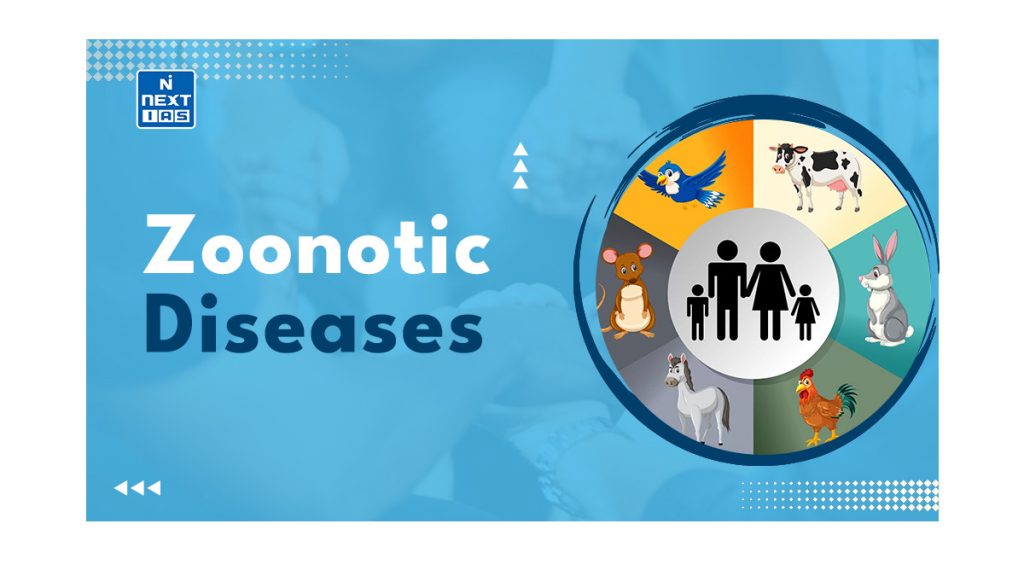
The interaction between humans and animals is a common occurrence, leading to various forms of contact. Zoonotic diseases, also known as zoonoses, refer to diseases or infections that can naturally be transmitted between vertebrate animals and humans, or vice versa. This article aims to provide a comprehensive overview of the Zoonotic Diseases and their classification, cause & impact.
Introduction
Astonishingly, over 60% of human pathogens have origins in zoonotic sources. This broad category encompasses a diverse range of microorganisms, including bacteria, viruses, fungi, protozoa, parasites, and other pathogens.
Multiple factors, such as climate change, urbanization, animal migration and trade, travel and tourism, vector biology, anthropogenic factors, and natural phenomena, have significantly influenced the emergence, re-emergence, distribution, and patterns of zoonotic diseases. As time progresses, the number of emerging and re-emerging zoonotic diseases continues to rise.
Types of Zoonotic Diseases
The wide spectrum of zoonotic diseases stems from diverse pathogens. Based on their etiology, zoonoses can be classified into several categories.
| Bacterial zoonoses, such as anthrax, salmonellosis, tuberculosis, Lyme disease, brucellosis, and plague, are caused by bacteria. |
| Viral zoonoses, including rabies, acquired immune deficiency syndrome (AIDS), Ebola, and avian influenza, originate from viruses. |
| Parasitic zoonoses, such as trichinosis, toxoplasmosis, trematodosis, giardiasis, malaria, and echinococcosis, are caused by parasites. |
| Fungal zoonoses, such as ringworm, are a result of fungal infections. |
| Other categories include rickettsial zoonoses (e.g., Q-fever), chlamydial zoonoses (e.g., psittacosis), and diseases caused by acellular non-viral pathogenic agents. |
Causes of Zoonotic Diseases
The emergence of zoonotic diseases can be traced back to the domestication of animals. Zoonotic transmission can occur in various contexts involving contact with or consumption of animals, animal products, or animal derivatives.
This includes companionship interactions (pets), economic activities (farming, trade, butchering, etc.), predatory behaviors (hunting, butchering, or consuming wild game), and research settings.
- Environmental factors such as climate change, unsustainable agriculture, wildlife exploitation, and land use changes play a significant role.
- Changes in human society, including increased mobility, have contributed to the spread of zoonoses.
- Contamination of the food or water supply is a significant pathway for zoonotic pathogens. Pathogens such as Escherichia coli and Salmonella are major contributors to foodborne illnesses.
- Farming, ranching, and animal husbandry activities also pose risks for zoonotic disease transmission. Close contact with farm animals can lead to diseases in farmers or individuals interacting with infected animals.
- Additionally, intensive animal farming, such as pig and chicken farming, has been identified as a primary risk factor for the spillover of zoonotic diseases.
- Veterinarians are also exposed to occupational hazards related to zoonotic diseases and require ongoing education and awareness.
- The wildlife trade and animal attacks contribute to the spillover risk of zoonotic diseases. The close proximity and increased interactions between different animal species in wildlife trade settings can facilitate the transmission of diseases.
- Additionally, insect vectors play a role in transmitting zoonotic diseases, such as African sleeping sickness, Dirofilariasis, and Zika fever.
- Pets, such as dogs and cats, can transmit various diseases to humans. These include rabies, ringworm, etc.
- Exhibitions involving animals, such as fairs, live animal markets, and petting zoos, have been linked to zoonotic disease outbreaks.
- Hunting and the consumption of bushmeat can increase the risk of zoonotic disease transmission. Notable examples include HIV and SARS, which are believed to have originated from the hunting and consumption of animals.
- The destruction of natural habitats brings humans into closer contact with animal species, leading to increased transmission of diseases.
- The reduction in biodiversity and changes in human-animal interactions can facilitate pathogenic spillover events.
- Climate change is also identified as a cause of the increasing number of zoonotic diseases, as it disrupts ecosystems and promotes the migration and interaction of species that may not normally come into contact with each other.
Impact of Zoonotic Disease
The impact of zoonoses can be evaluated by considering factors such as disease prevalence, incidence, morbidity, mortality, and economic loss.
Physical and Mental Health
- Affected individuals often face obstacles that hinder their work performance, thus limiting their ability to provide for their families.
- These challenges are particularly prevalent in underdeveloped regions of Africa and Asia.
- In some cases, those affected may become socially isolated, increasing their vulnerability to mental health issues.
- Antibiotic resistance poses a significant global health challenge, further complicating the treatment of bacterial zoonoses.
- Patients infected with antibiotic-resistant bacteria require special attention and costly medications, placing a burden on the healthcare system, particularly in developing countries.
Economic Losses
- Zoonotic diseases not only cause animal deaths but also lead to substantial economic losses in the livestock sector of any given country.
- Even if animals do not succumb to diseases, their health, and productivity can be severely affected. This can result in significant reductions in the production of animal-derived products, such as meat, milk, and eggs, often exceeding 70%.
- Consequently, human health and nutrition suffer due to decreased availability of high-protein animal-based foods.
- Zoonotic diseases, such as brucellosis and toxoplasmosis, can also cause infertility, abortion, and weak offspring in animals, resulting in substantial economic losses for farmers and the entire country.
- Furthermore, zoonotic diseases like BSE (bovine spongiform encephalopathy), avian influenza, and anthrax can disrupt the international trade of animals, animal products (such as meat, milk, and eggs), and related byproducts worldwide.
- The economy also experiences significant repercussions due to the measures required for zoonoses control and eradication, including zoonotic disease surveillance, diagnosis, isolation, and quarantine protocols.
Solutions to the Threat of Zoonotic Disease
Recognizing the complex interrelationships among human, animal, and environmental health, international organizations and researchers have adopted the “One Health” concept.
- The One Health concept encourages collaboration among wildlife biologists, veterinarians, physicians, agriculturists, ecologists, microbiologists, epidemiologists, and biomedical engineers to ensure the promotion of health in animals, humans, and the environment.
- This approach has far-reaching impacts on poverty alleviation, food security, and health security, primarily in developing countries, by focusing on the prevention and control of zoonoses.
- Multi-sectoral collaboration, and partnerships to implement effective surveillance and intervention strategies across human, animal, and environmental domains.
- It proposes several recommendations under the One Health approach, including establishing “Zoonotic Disease Units” to enhance collaboration between human and animal health agencies, developing national strategies for these units, engaging multidisciplinary leadership to prioritize zoonotic disease research, and adopting veterinary public health policies with international collaborators.
- It suggests One Health Zoonotic Disease Prioritization to prevent and control zoonotic diseases.
Conclusion
Zoonotic diseases pose a significant threat to public health, often originating from animals and subsequently affecting humans. Factors such as changes in food habits, climate change, and human activities contribute to the emergence and re-emergence of zoonotic diseases through increased human-wildlife contact.
Thus, the need of the hour is a holistic and comprehensive approach to dealing with threats. International collaboration and an integrated approach will help in tackling this issue.
FAQs
What are common Zoonotic Diseases?
Common zoonotic diseases are diseases that can be transmitted between animals and humans. Examples include rabies, influenza, salmonellosis, Lyme disease, and Ebola. These diseases can spread through direct contact with infected animals, consumption of contaminated food or water, or exposure to vectors like mosquitoes and ticks.
Why are Zoonotic Diseases?
Zoonotic diseases exist due to the close interactions and shared environments between humans and animals. When pathogens or infectious agents jump from animals to humans, they can cause zoonotic diseases.
Factors such as increased human encroachment into natural habitats, the wildlife trade, intensive farming practices, and climate change can contribute to the emergence and transmission of zoonotic diseases.
What are two Zoonotic Diseases examples?
Two examples of zoonotic diseases are:
– Avian influenza (bird flu)
– Lyme disease
What are the four types of Zoonoses?
The four types of zoonoses are:
a) Direct zoonoses: These occur when the pathogen is transmitted directly from animals to humans through contact with infected animals or their bodily fluids.
b) Indirect zoonoses: These occur when the pathogen is transmitted through an intermediate source, such as contaminated food or water.
c) Vector-borne zoonoses: These occur when vectors like mosquitoes, ticks, or fleas transmit the pathogen from animals to humans.
d) Transplacental zoonoses: These occur when the pathogen is transmitted from a pregnant animal to its offspring, which can then be transmitted to humans during pregnancy or childbirth.
Is Dengue a Zoonotic Disease?
No, dengue is not considered a zoonotic disease. It is a mosquito-borne viral infection caused by the dengue virus, primarily transmitted to humans through the bite of infected Aedes mosquitoes.






